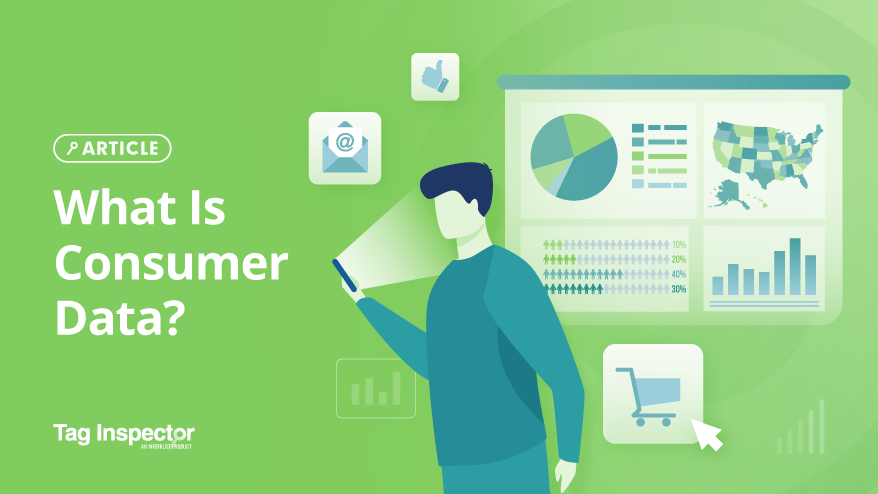These days it seems like more and more people are asking this question. Most people have heard of consumer data but have a hard time tangibly defining it. So, what is it?
Simply put, consumer data is the information companies collect about individuals to better understand their behaviors, interests, and preferences. Every industry, from retail, to entertainment, finance, and even healthcare rely on this data to help them in a multitude of ways, whether it be to improve their products and services or personalize their marketing efforts.
While the term consumer data refers to a variety of data points, it is most commonly used in reference to things that provide insight into who a consumer is like demographic information, location data, and behavior patterns. These data points are collected in many ways, but in the digital age the majority of the collection of consumer data is happening online.
Collecting Consumer Data
Whether it be when a user browses a website, uses a search engine, or scrolls on social media, more often than not their interactions and preferences are being monitored and stored by companies for future use. With the ever-growing presence of technology becoming more of a cemented fixture of everyday life, people are relying on things like social media, online shopping, and digital news outlets more than ever, which only makes their information more readily available to companies. These companies are in turn using this information to create personalized experiences, improve customer engagement strategies, increase loyalty, and ultimately increase sales.
As an example, demographic information, like a consumer’s age, gender, income, or occupation, can directly inform a company as to who their primary buyers are and who they should cater their marketing efforts towards. This could mean targeting returning customers, but it can also provide insight into new potential marketing opportunities, such as groups that they may have ignored in the past.
Behavioral data, such as what products a consumer buys, how often they buy them and what they typically spend is very powerful information that can give companies insight into someone’s buying habits. By knowing what is being bought, and by whom, companies can identify patterns and trends that inform what products they want to target with their marketing campaigns and promotions.
The fact that this data is being collected will not be news to most people, but how it is collected can seem elusive. How can the companies know what people are buying just by them looking at a website or liking a post on social media? Where is the collection actually happening?
Understanding Cookies and Tags
One of the most common ways that companies collect consumer data online is through the use of cookies and tags. While practically everyone has heard of cookies, very few people would be able to define what they are, and even fewer have heard of tags. Cookies are small text files that are stored on a user’s device when they visit a website that contain information about the user’s browsing history and preferences. This information, as well as data on the user’s interactions, is then communicated back to the company and their various advertising partners via tags, also known as pixels, that send this information back to their servers in something called a network request. These requests are triggered by certain actions taken by the user, such as clicking on a link, adding an item to their cart, or completing a purchase, allowing the company to know exactly how the consumer is using their platform.
The consumer’s data can also be collected in more obvious ways as well, like loyalty rewards programs or surveys, which typically require consumers to provide personal information, such as their email, name, and phone number. In conjunction with the interaction data collected through cookies and tags, this kind of data is a company’s most useful asset when it comes to learning who their customers are and retargeting them for future sales. This is why companies incentivize signing up for these programs with things like rewards points, special offers, and exclusive access to other perks not available to anonymous consumers. If they know who their consumers are then they have to spend less money guessing.
Staying Ethical While Collecting Data
One of the challenges that companies face when collecting consumer data is ensuring that it is collected ethically and with the consumer’s consent. In recent years there have been an increasing amount of high-profile data breaches and scandals, which have led to increased scrutiny of how this data is being used. As users become more aware of the collection of their information (both intentionally and unintentionally), they are asking for more protections and guarantees that the information being collected on them is safe and secure.
To address these concerns, many countries have implemented data protection laws and regulations, such as Europe’s GDPR or California’s CCPA and CPRA. These regulations set out strict rules for the collection, storage, and use of personal data that are enforced with massive fines in an attempt to deter companies from unethical collection practices and put the consumer’s mind at ease. These kinds of regulations are becoming more prevalent each year and are forcing companies to examine how they use consumer data, reshaping the landscape of the marketing industry.
Despite the risks involved with improper compliance practices, consumer data continues to remain one of the most valuable resources for businesses. As such, the responsibility lies with the consumer to know when their data is being collected as a way of enforcing that companies are transparent about their collection practices and ensuring that their data is collected, stored, and used responsibly and ethically.
